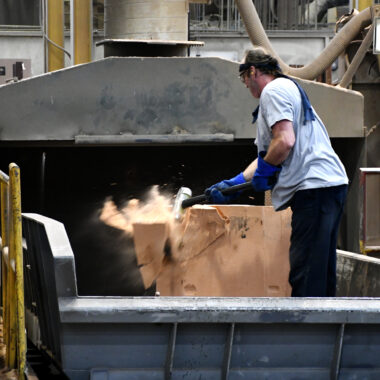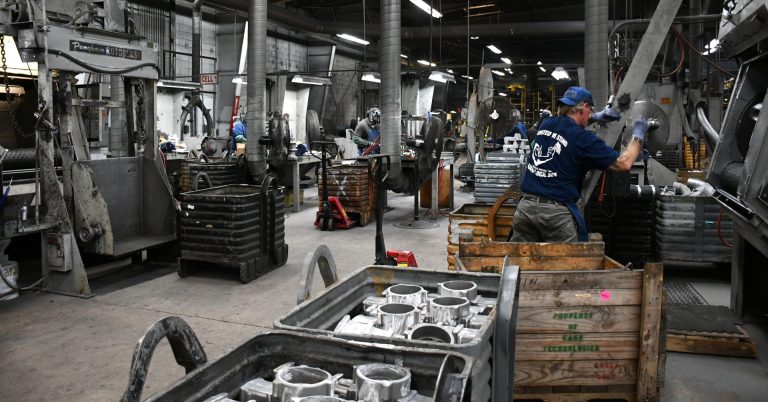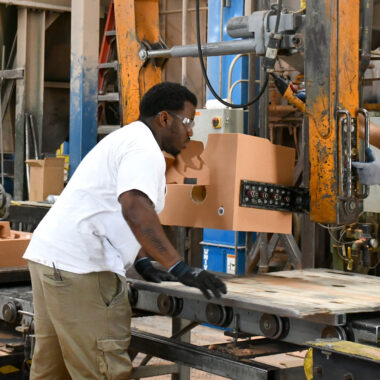Maximizing Performance: Advanced Aluminum Casting Solutions Revealed
Maximizing Performance: Advanced Aluminum Casting Solutions Revealed
Blog Article
Exploring the Different Methods of Light Weight Aluminum Spreading: A Comprehensive Overview
Aluminum casting stands as a basic process in the creation of many products we encounter daily, from complex vehicle elements to house components. Understanding the varied methods used in aluminum spreading is critical for makers looking for accuracy and effectiveness in their manufacturing procedures - aluminum casting. As we start this exploration of the different techniques involved in light weight aluminum spreading, we reveal a world where development and tradition merge to shape the products that form our contemporary globe
Sand Casting Method
Utilizing one of the oldest and most extensively made use of approaches in aluminum casting, the sand spreading technique includes producing molds from a mixture of sand and a binder material. This technique is very versatile, economical, and suitable for producing a wide variety of sizes and forms, making it a preferred choice in various industries.

Light weight aluminum, warmed to its melting factor, is after that poured right into the mold, filling the cavity. After cooling down and strengthening, the sand mold and mildew is damaged away, exposing the aluminum casting. This approach enables the production of intricate geometries and is fit for both reduced and high volume production runs.
Financial Investment Casting Strategy
Having checked out the sand casting method, a polished method to light weight aluminum spreading is the investment spreading technique, which offers distinctive benefits in regards to accuracy and surface finish. Financial investment spreading, likewise called lost-wax spreading, is a procedure that includes producing a wax pattern that is covered with a ceramic shell. When the shell is dried out and solidified, it is heated up to eliminate the wax, leaving a hollow ceramic mold. Molten light weight aluminum is then put into the cavity, filling the mold and mildew to create the wanted component.
Additionally, financial investment spreading is recognized for its excellent dimensional precision and tight tolerances, making it a favored method for generating parts that require limited specs. On the whole, the investment spreading strategy is a effective and flexible approach for producing premium aluminum elements.
Long-term Mold And Mildew Process

One of the key advantages of the Long-term Mold Refine is its ability to generate parts with a finer grain framework, resulting in improved mechanical homes. By leveraging the Long-term Mold and mildew Refine, makers can achieve economical manufacturing of aluminum components with exceptional dimensional precision and surface finish.
Pass Away Casting Method
As opposed to the Permanent Mold Process, the Pass Away Casting Method for light Click Here weight aluminum spreading includes making use of a recyclable steel mold to create detailed parts with high dimensional precision. This method is commonly used in various sectors because of its capacity to efficiently mass-produce complicated shapes with slim wall surfaces and excellent surface area coatings.
Pass away casting commonly begins with the prep work of the steel mold and mildew, which is after that sprayed with a lubricant to facilitate the removal of the strengthened light weight aluminum. The mold is shut, and molten aluminum is infused under high stress into the tooth cavity. Once the light weight aluminum strengthens and cools down, the mold opens, disclosing the finished component.
Among the essential advantages of die spreading is its high production rate, making it a cost-efficient remedy for massive production. In addition, parts produced via die spreading exhibit remarkable strength and toughness contrasted to those made through various other casting techniques. This approach is particularly ideal for applications requiring elaborate designs, tight tolerances, and high repeatability.
Centrifugal Spreading Method
How can the Centrifugal Spreading Approach boost the effectiveness and top quality of light weight aluminum spreading procedures? Centrifugal casting is an approach that utilizes centrifugal pressure to disperse liquified steel right into a mold tooth cavity. This method offers several benefits over typical casting techniques.
One trick advantage is the remarkable high quality of the castings created. The centrifugal force assists to eliminate porosity by pushing any kind of gas or pollutants in the direction of the center of the casting, resulting in a denser and a lot more consistent final item (aluminum casting). Furthermore, the rotational activity of the mold ensures a more also circulation of the liquified metal, causing boosted mechanical residential properties and minimized problems
The method enables for the spreading of detailed forms and thin-walled parts with convenience, broadening the style opportunities for producers. In final thought, the Centrifugal Spreading Approach stands out as a reputable method for improving both the efficiency and quality of aluminum casting processes.

Final Thought
In conclusion, the various approaches of light weight aluminum casting offer one-of-a-kind advantages and qualities for various applications. Sand casting offers flexibility and cost-effectiveness, financial investment spreading enables for complex layouts, permanent mold and mildew procedure makes sure high-quality coatings, die casting gives high manufacturing prices, and centrifugal spreading creates high-strength parts. Comprehending the distinctions between these methods can assist suppliers select the most appropriate technique for their details spreading needs.
Having discovered the sand casting method, a polished approach check my reference to light weight aluminum casting is the investment spreading technique, which provides distinct advantages in terms of precision and surface coating. Financial investment casting, also understood as lost-wax spreading, is a process that entails creating a wax pattern that is covered check my source with a ceramic shell.Exactly how can the Centrifugal Spreading Technique boost the efficiency and high quality of aluminum spreading processes? In conclusion, the Centrifugal Spreading Technique stands out as a trusted strategy for improving both the performance and high quality of aluminum spreading procedures.
Sand casting provides adaptability and cost-effectiveness, investment casting permits for detailed layouts, long-term mold procedure makes sure top quality finishes, pass away casting offers high production prices, and centrifugal casting generates high-strength parts.
Report this page